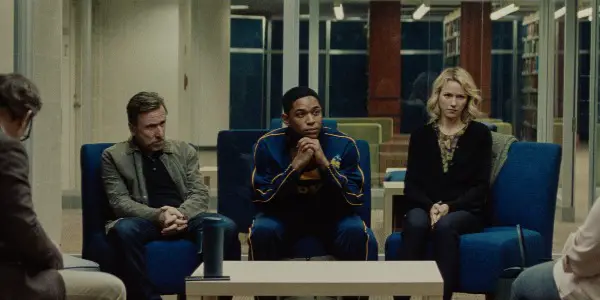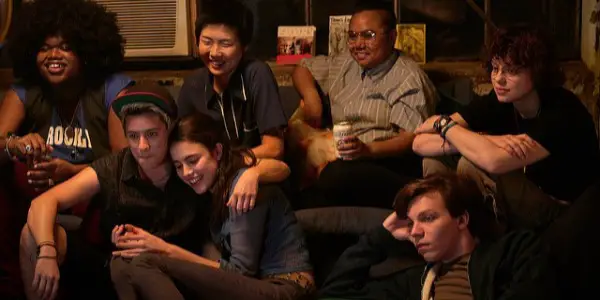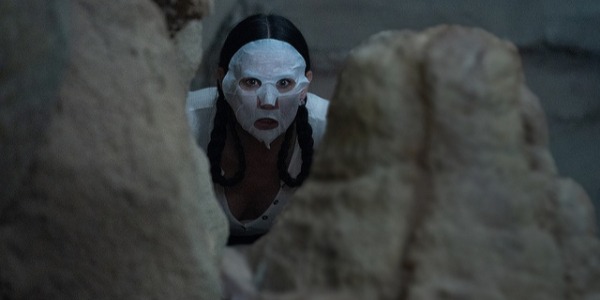Sundance Film Festival 2019 Report 7: HAIL SATAN?, LUCE, ADAM, SWEETHEART & CORPORATE ANIMALS

Alex is a film addict, TV aficionado, and book lover.…
The 2019 Sundance Film Festival may be over, but we’re still sorting through everything we saw here at Film Inquiry. Here’s another roundup of the far-reaching films the festival had to offer, from satanist docs to monsters from the deep (two of those, actually).
Hail Satan? (Penny Lane)

Religious influence in American politics had an unexpected countermeasure in the rise of The Satanic Temple, a deeply misunderstood organization that director Penny Lane playfully profiles in her latest documentary, Hail Satan?.
The question mark in the title gets at the most erroneous assumption people make about The Satanic Temple: that its members genuinely worship Satan and are spreading his evil works throughout the world. Much of the vitriol directed at the group comes from this notion, and it’s one of the first things Lane pushes against.
In the opening scenes, we see leaders of the group, or at least those willing to go in front of a camera, brainstorming the right outfits for a media event in which they will declare support for tea party candidate Rick Scott. They search costume shops and land on some kitschy numbers: black robes and masks for the entourage, horns and a sad little fire effect for the main speaker. They’re having fun with the whole thing, an early hint that the devilish accouterments really aren’t so precious to them.
As Lane pulls back the veil on the firebrand group, what comes into focus are the individual members that make the organization thrive: the misfits, weirdos, and people who never quite got the niceties of mainstream culture. Their distance made it easier for them to see the hypocrisies at work, and if anything bonds them its their desire to push back against these cultural blind spots, not their worship of Satan.
As with Lane’s previous work, Hail Satan? takes a remarkably lighthearted tact in dealing with its subjects. There’s a certain cheeriness to the proceedings, one that makes the movie feel like its peppered with inside jokes that you’re being let in on. This is most obviously a result of Lane’s irreverent worldview, something she seemingly shares with several members of The Satanic Temple. But it’s also thanks to her unfussy approach to documentaries, which may immediately strike you as a plain blend of interviews and boots on the ground footage. What this is doing, though, is minimizing the distance between subject and viewer, making it seem like you’re getting a relatively unfiltered look at The Satanic Temple when in reality Lane is carefully guiding you through a sympathetic look at an organization experiencing growing pains.
The complexity that Lane is able to achieve in its brief runtime is impressive, first tackling misconceptions, then explaining what the organization is actually about, and then calling into question whether those tenants are actually being followed. While loving, this isn’t a fluff piece, and the film leaves you with a more accurate understanding of both The Satanic Temple’s accomplishments and the questions you should be asking about them.
Unfortunately, that does leave Hail Satan? with little time to look at things outside of the temple, so its portrayal of other religious groups (predominately Christian) is limited to the more extreme varieties that the temple targets. Given that mainstream religions already get plenty of time in the sun, though, I wasn’t bothered by this limited look; we can all bring our knowledge of functioning, moderate religious practitioners to our understanding of The Satanic Temple’s work, and the fact is that those people don’t really play a part in the battle being waged.
Hail Satan? delivers everything you want from a movie with such a cheeky title; it’s knockout funny, wickedly smart, and a grand time at the cinema. See it with a crowd if you can, and maybe lead a little ‘hail Satan’ of your own.
Luce (Julius Onah)

Everybody is stuck between a rock and a hard place in Luce, and as per usual, that doesn’t bring out anyone’s best side.
On the surface everything seems fine and dandy. Luce is a teen who rose above the worst kind of childhood, having been plucked from war-torn Eritrea and adopted by an American family who could give him the support he needed. Therapy, good schools, and a stable home turned him into a model young man, and as the film opens he’s basically being paraded around as the poster child of American success.
If that description makes you cringe, then you’re primed and ready for the twisty, challenging tale that Luce offers up. Whether the teen is everything he seems on the surface or something much more sinister is the main question, but to find the answer you have to wade through prejudices so thick that they’ll still be swirling in your head as the credits roll.
This state of confusion is what the film is all about, challenging the viewer to probe their own biases as the angles are picked apart one by one. Are the parents forgiving too much in order to give their son a shot? Is the school protecting their star pupil? Does the teacher raising these concerns have it out for Luce? The possibilities are laid out in excruciating detail, and with Luce running around wearing an indecipherable smile, the mystery is sustained through even its most ridiculous red flags.
Director and co-writer Julius Onah adapts this tense standoff from a play of the same name, but the film never feels restricted in the way play adaptations can. Yes, this is mostly a series of conversations, but Onah leans so heavily on thriller staples in his shot construction and editing that the story feels entrenched in its new medium.
The key to making this whole thing tick, though, is having an inscrutable character at its center, and Kelvin Harrison Jr. turns in a perfectly measured performance as Luce. Bouncing between charm and menace could easily have made this character seem inconsistent, or even worse turned him into a cipher, but Harrison Jr. finds ways of turning his smile just enough that you question whether there was a change at all.
Naomi Watts and Tim Roth as the conflicted parents bounce off each other like the familiar pros they are (they were both in the Funny Games remake), as does Watts and Harrison Jr. (who also co-star in another Sundance film, The Wolf Hour). But its arguably Octavia Spencer as the wary teacher who must handle the most direct and complex character of the bunch. She knows when she’s being played (or at least she thinks she does), but she’s surrounded by people who are unwilling to imagine Luce as she sees him. How this plays into her character’s worldview that everyone exists in boxes is both frightening and saddening, and its the scenes between her and Harrison Jr. that really crackle.
These taut scenes are what Luce is all about, leaving you dangling with your own questions as the film swiftly moves on to new ones. This makes its few implausible moments easy to forget and allows Luce to be both challenging and crowd-pleasing.
Adam (Rhys Ernst)

Growing up is hard for everyone, but imagine growing up as a straight, cisgender man within the LGBTQ community of New York City in the mid-2000s. The worst.
This playfully twisted fish out of water scenario is indicative of the lighthearted way Adam takes on a myriad of identity and hypocrisy issues within the LGBTQ community and spits them out for general audiences to understand. However, it also means that there’s a lot of material people will find offensive, and it’s probably best that we address those right off the top.
The titular Adam is a high schooler visiting his queer older sister for the summer. Dumped into her world of heavily-opinionated activists with little knowledge himself, he just wants to meet a girl and embark on a summer romance. Problem is that his boyish looks cause him to be mistaken for a trans man, and he rolls with the misidentification in order to have a chance with a cute girl.
So yeah, problems. People had knee-jerk reactions to the book on which this is based, rightly objecting to the potentially transphobic premise, questions of consent, and the pervasive problem of minority cultures being filtered through the lens of straight, white men. All of these, though, are addressed in the film adaptation, and whether or not you feel these are adequately dealt with will be key to whether you end up rolling on the floor from laughter or despair.
Personally, I enjoyed the irreverent take on the intersection between gender and sexuality, and I liked seeing it addressed by characters that aren’t saints. Uptight, carefully measured explorations of these issues have their place, but so should messy, cutting satire, of which Adam has plenty.
To opine that Adam is unaware of the culture it’s exploring is simply preposterous. From jokes that will land only for those in the know (an L Word watch party hits on both the horrendous facial hair of Max and the cringeworthy biphobia of some viewers) to gut-busting lines everyone will understand (a bit about whether being trans would be central to your identity needs no explanation), Adam works as both a send-up of mid-2000s queer culture and a way to introduce people to topics they may not be well-versed in.
While saying the film charms its way out of issues would be reductive (it’s got more intelligent tricks up its sleeve), the naive earnestness that Nicholas Alexander brings to the titular character does go a long way. This kid could have been repulsive, but instead Alexander walks the line of being honest about the repulsive things he does without making him into a monster. And when the film does eventually let him off the hook too easily, Alexander and co-star Leo Sheng deliver a final exchange so winning that it’s hard not to walk out of the film with a smile on your face.
Director Rhys Ernst took a bold step in adapting this difficult material for the big screen, and what he delivered was a surprisingly hilarious, complicated look at a pivotal moment in queer culture. Will it be too much for some people? Absolutely. Will others relish its side-eyed send-up? I did, at least.
Sweetheart (J.D. Dillard)

The creature feature gets a no-nonsense entry in Sweetheart, a minimalist take on the woman-versus-fish man subgenre. Having grown up on Creature from the Black Lagoon, the standoff seemed cozily familiar; the monster just wants to drag her into his underwater lair, but this time, instead of romantic motivations, the terrifying creature is more interested in her culinary potential.
Kiersey Clemons came upon this hellish situation quite by accident. The boat she and her friends were on had sunk, and at first it seems she is the only survivor. A few supplies and bodies wash up on the remote island, which she scavenges with refreshing intelligence. She’s no damsel in distress, which is a damn good thing, because no one is coming to save her.
The creature itself, of course, doesn’t appear right away. You have to tease out the reveal, first with some unexplained occurrences and then with fleeting glimpses of the otherworldly beast. Building a little mythology is half the fun, and Sweetheart does this with mixed results.
Since Clemons is alone, much of the early exploration of the island is done in silence, with Clemons’ magnetic star power and a few portentous edits being relied upon to keep things going. These aren’t quite enough for this section’s length, though, as the clues being dropped are pretty standard to the genre. Things kick off once the presence of a creature is revealed, though, in a spine-tinglingly glorious shot that director and co-writer J.D. Dillard said was the seed for the entire film.
Cat and mouse games ensue, with things like backstory and character development mostly being left by the wayside. It’s enough of a statement that Clemons is so capable, managing to put together makeshift defenses and hideouts to survive the creature’s nocturnal stalking. Movies rarely make their female protagonists so self-sufficient, even when they are literally the only ones on an island with a beast, and this represents the only twist that Sweetheart offers up.
Whether that is enough to sustain your interest is the key here, because despite how well done the monster is once he appears (and he’s a great mix of CGI and live-action effects), this is an obstinate throwback to simple creature features. Sweetheart doesn’t even give its fish man an ounce of sympathy, something that the early heyday of King Kong and Frankenstein did with relish. No, Sweatheart is a straightforward survival tale, and the little bits it does add to its spare story are rather inconsequential.
Thankfully, Sweetheart has the self-awareness to keep it short, so those in for a down and dirty creature battle should be satiated. Those wanting anything more, though, will likely leave disappointed.
Corporate Animals (Patrick Brice)

Noting that workplaces are battlegrounds, with employees jockeying for advancement and petty disagreements boiling into outright rage, is hardly a novel observation, and neither is treating these dynamics literally to create a horror/comedy mashup. More must be done to stand out, like maybe landing Demi Moore to play the egomaniacal boss who pushes her employees into a doomed spelunking trip in the name of team building.
Yeah, that’s the setup to Corporate Animals, the latest film to turn a business retreat into a bloodbath. Enough pieces are there to make it seem promising; it’s always nice to see Moore pop back up, but the real stars are the outstanding ensemble she has around her, from Jessica Williams and Karan Soni as her put-upon proteges to Ed Helms as their bored guide through the caves. It’s a case where you recognize everyone in the cast, even if you can’t put your finger on who they are, and that gets things off on the right foot.
That goodwill quickly goes out the window, though, as early comedic setups are too broad and laborious to land. An ad for their ridiculous company, which makes edible cutlery, isn’t biting enough, and a protracted gag in which they fail a teamwork puzzle feels entirely unnecessary. By the time the group gets underground and stuck in a cavern, you can feel any sense of comedic timing slipping away from this painful film, and then it inexplicably starts keeping track of time with intertitles showing the days passing by (which, unsurprisingly, isn’t as funny as intended).
Things pick up a little once the main scenario kicks in, and the excellent cast does their best to prop up the few winning gags at their disposal. Particularly Williams and Soni show some excellent chemistry as antagonists turned allies, benefiting from having the only true arcs in the film.
But mostly, this movie founders in rambling, sporadically funny asides, seemingly stuck in limbo along with its characters. It desperately needs a structure outside of its ticking clock, something to give these characters a reason to get out, but none of them seem to have a great life above ground. Wallowing in the dirt and listening to hallucinated Britney Spears songs (yeah, that’s this film’s idea of a running joke) doesn’t seem like that bad of a time for them, or at least it wouldn’t be if they weren’t also starving to death.
Sure, survival is worth going for, but why are we watching then try? The film has little to say about corporate culture, nothing that approaches actual horror, and only a handful of decent jokes. Director Patrick Brice even struggles to make their little cavern seem at all restricting or treacherous, so really, what is the point of this film?
Oh right, I’m supposed to answer that. There is none.
That’s another round of films from the 2019 Sundance Film Festival. Did any of them seem interesting to you?
Does content like this matter to you?
Become a Member and support film journalism. Unlock access to all of Film Inquiry`s great articles. Join a community of like-minded readers who are passionate about cinema - get access to our private members Network, give back to independent filmmakers, and more.
Alex is a film addict, TV aficionado, and book lover. He's perfecting his cat dad energy.













